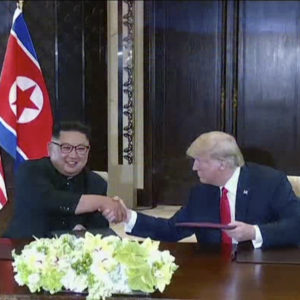In what has now proved to be a premature declaration, President Trump recently tweeted, “There is no longer a nuclear threat” regarding North Korea. However, satellite imagery has since revealed an expansion of a missile-manufacturing site in North Korea, and the secretary of state recently acknowledged to Congress that Pyongyang is still producing bomb fuel.
With bated breath, the world will continue to watch Secretary Mike Pompeo and Trump negotiate with Kim Jong-un. But in the event that Pyongyang’s nuclear program continues to expand, policymakers should develop a prudent defense policy that will prepare the U.S. homeland for the worst.
One such policy would be upgrading our missile defense systems — particularly ground-based midcourse defense (GMD) systems, which are designed to intercept intercontinental warheads in space after the rocket burns out. But some critics allege GMD is unreliable, and a recent report from the Government Accountability Office criticized the Missile Defense Agency for a “troubling pattern” of awarding large development contracts that do not include final costs or quantities, thereby exposing “the government to increasing amounts of risk.”
The system also “failed to deliver either of its two most recent packages of integrated capabilities on time,” and suffers from cyber vulnerabilities that place operations in “certain geographic areas at risk.”
It’s true, U.S. missile defense systems are imperfect and financially costly — the planned improvements to the GMD system would make it the Pentagon’s fourth most expensive weapons system. But the stakes — protecting potentially millions of Americans from a nuclear attack — are too high to neglect defense priorities in a world of nuclear actors. That our missile defense systems are costly and still have kinks to work out is not an excuse for failing to protect Americans from a nuclear strike.
The reality is that GMD systems currently constitute our best defense against the types of missiles North Korea would use to attack American territory.
Despite the challenges that GMD systems face, the GAO report also pointed to substantial successes. The system conducted its first successful flight test of an improved interceptor last year “when it successfully intercepted a target representative of an intercontinental ballistic missile.”
The program also upgraded its battle management and discrimination in addition to a preliminary design review for a hit-to-kill warhead, executing all of these actions “while also maintaining 24/7 availability of the system to the warfighter during a heightened period of North Korean missile testing.” Even considering these successes, there is much more work to be done.
Last year’s National Defense Authorization Act (NDAA) advised increasing the number of deployed Ground-Based Interceptors, the missile components of the GMD system. While the government report highlighted the missile defense system met a goal by increasing the number of interceptors from 30 to 44, it is estimated that North Korea may have up to 60 nuclear warheads with plans to increase that number. Further complicating things, multiple GBIs may need to be expended for each incoming warhead so more will need to be deployed across the United States. (The NDAA recommended deploying up to 104 GBIs at two locations in Alaska and California.) Going forward, the Trump administration should further beef up this system.
Other improvements to our missile defense systems are necessary as well.
Developing a Multi-Object Kill Vehicle would allow a single interceptor missile to destroy multiple incoming warheads instead of just one. This would drastically bolster our defense capabilities.
Still, the focus shouldn’t be exclusively on intercepting missiles during their midcourse phase (when they’re at their highest trajectory), which is aptly described as trying to “hit a bullet with a bullet.” It’s better to take out a missile on take-off. Targeting the boost phase (the period from launch until the boosters burn out) has the advantage of intercepting missiles when they are moving at slower speeds and before the warhead has separated. Options for boost-phase interceptors include air-to-air missiles on fighter planes or drones, cyberattacks or laser-mounted drones.
Future peace talks with North Korea are to be lauded, and we should all hope for an outcome of successful disarmament on the Korean Peninsula. But there are plenty of reasons to be skeptical of Kim’s commitment to giving up nuclear weapons, and it would be a mistake to let our guard down out of optimism. Despite the challenges GMD and other missile defense systems present, policymakers should prioritize upgrading and expanding our missile shield.
In the next round of negotiations, Trump should work tirelessly for peace but prepare for the worst.

